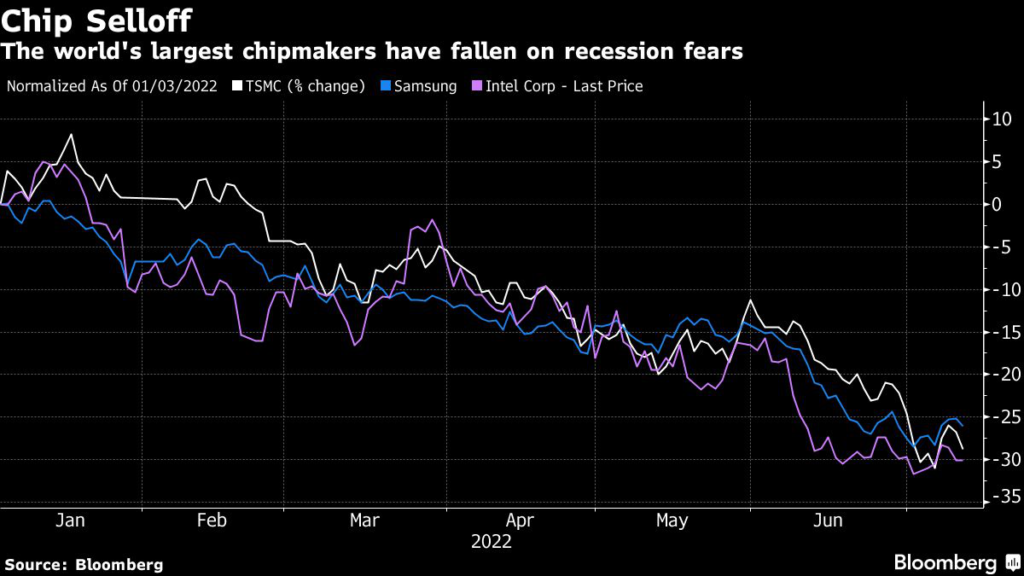(Bloomberg) — SK Hynix Inc. is considering cutting its 2023 capital expenditure by about a quarter to 16 trillion won ($12.2 billion) in response to slower electronics demand than anticipated, people familiar with the matter said.
The world’s second largest memory maker is sticking largely with plans to spend about 21 trillion won this year building up DRAM and NAND capacity, the people said. But rising uncertainty over dwindling demand for the chips that go into everything from smartphones to servers has forced a rethink of expansions next year, they said, asking not to be identified talking about undisclosed plans.
The Apple Inc. supplier’s move comes as global tech companies sound the alarm over macroeconomic risks from rising interest rates, which is turning consumers off pricey gadgets. Hynix hasn’t made a final decision about capacity expansion plans, the people said.
The company’s shares rose 5% in Seoul on Friday, their biggest gain in four months, after investors bet Hynix’s cut would put a floor under chip prices by reducing an inventory glut. Samsung Electronics Co., the world’s biggest memory producer, was up 4.4%, its biggest single-day climb since December.
Fellow memory maker Micron Technology Inc. said at the start of this month that it plans to slow supply expansion next year and use existing inventory to fill part of the market demand. It expects capex to decline year-on-year. Taiwan Semiconductor Manufacturing Co., the world’s biggest contract chipmaker, said on Thursday it could trim spending on expansion by as much as 9% this year from initial projections.
“We have not decided whether to change our capex plan for next year,” Hynix said in a statement.
Read more: TSMC Hikes Outlook Yet Delays Spending as Uncertainty Persists
Apple is TSMC’s biggest customer, accounting for an estimated quarter of its revenue. Chief Executive Officer C.C. Wei told analysts on a conference call he was unconcerned about potential inventory buildups of high-end smartphones. In April, the iPhone maker said it was grappling with supply-side constraints that could shave as much as $8 billion off revenue in the June quarter.
“We expect limited supply growth due to memory makers’ disciplined capacity addition, rising difficulties in memory fabrication, tech migration’s decelerating contribution to bit growth, and foresee supply-driven memory recovery throughout 2023E,” Citi analysts wrote in a report.
Chip stocks including Hynix, Samsung and Micron have fallen more than 25% this year as companies wrestle with a potential global recession.
But investors have recently bought back Samsung and TSMC, judging them oversold. Last week, Korea’s largest company triggered an Asian stock rally when it reported a better-than-projected 21% jump in revenue. On the flip side, Micron warned of oversupply and gave a surprisingly downbeat forecast for the current quarter.
Read more: Samsung Sparks $30 Billion Tech Rally After 21% Sales Jump
The memory chip industry, which has historically endured repeated boom-and-bust cycles, is particularly sensitive to signs of a glut or shortage in supply.
Many industry observers regard capacity cuts by major players as a signal that they anticipate slowing demand and are moving to protect prices. Companies like Hynix tend to control supply, to prop them up.
In April, Hynix predicted a bounce-back in PC and smartphone sales in the seasonally stronger second half of 2022, depending on how long China’s Covid-19 lockdowns fare. Curbs across many of the country’s major cities including Shanghai began to relax around June.
The company will report earnings July 27.
(Updates with share price)
More stories like this are available on bloomberg.com
©2022 Bloomberg L.P.











